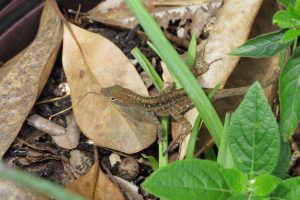In our continuing battle with invasive species, northwest Florida is now home to an invasive lizard. Known as both the Cuban and Brown Anole, this animal has been reported from Big Lagoon, East Hill, North Hill, and Gulf Breeze in the Pensacola area. I have seen it at almost every rest area on I-10 between here and Gainesville and in large numbers at some local nurseries.
Who is this new invader to our area?
We will start with “new”.
Compared to the rest of the state, it is new. First reported in 1887, this lizard hitchhiked over from its native Cuba and Bahamas via boats. DNA studies suggest there were at least seven different “invasions” of the lizard to Florida. This is not surprising since the lizard is small (between 5-8 inches) and likes moist areas to lay eggs. A fan of warmth, vegetation, and insects – it did very well once it arrived. Like most invasive species, it quickly spreads into disturbed areas… and we have disturbed Florida in a major way. It is now found in all counties within the Florida peninsula and in many, it is the most common lizard seen.
Is it an “invader”?
Yes, in the sense that it moves into disturbed habitats quickly and competes with the native Green Anole (Anole carolinensis). Both lizards are beneficial to humans in that they consume great numbers of insects and spiders. However, the Cuban Anole will consume the eggs and juveniles of the Green Anole. Where the two co-exist, the Green Anole is forced to live higher up in the vegetation. This is a form of resource partitioning where each species is co-existing in the same area but not directly competing. However, biologists are not sure how this co-habitation of the two lizards will affect local ecology. It is currently listed as an invasive species in Florida.
So is it new to the panhandle?
Well, based on records – yes. Based on anecdotal comments – no. Some folks have seen it for some time now. The most probable means for dispersal have been with forms of transportation visiting the panhandle from south Florida and the transport of landscaping plants from south Florida nurseries. One local nursery had a greenhouse over-run with the lizard. If you view the invasive database EDDMaps. It shows 13 records between Alabama and the Aucilla River. There are certainly more than that. EDDMaps has the distribution broken down as:
| County | Number of Cuban Anole Records |
| Bay | 1 |
| Calhoun | 0 |
| Escambia | 0 |
| Franklin | 0 |
| Gadsden | 0 |
| Gulf | 0 |
| Holmes | 0 |
| Jackson | 1 |
| Jefferson | 0 |
| Leon | 2 |
| Liberty | 0 |
| Okaloosa | 4 |
| Santa Rosa | 4 |
| Wakulla | 0 |
| Walton | 0 |
| Washington | 1 |
Several local residents have sent me photos of the Cuban Anole in Pensacola (used in this article). I will need to post these soon and we will need help from the public posting more. To report anoles, you will need to log into EDDMaps at www.EDDMaps.org. You will need an account, but it is free. You can also download their app “I’ve Got 1”, which can be found on the website. If you have questions about EDDMaps, please contact me at the Escambia County extension office (850) 475-5230.

This Cuban Anole was photographed at the east end of Big Lagoon near NAS Pensacola.
Photo: Carole Tebay
Until then, check your cars before heading back from south Florida and any plants you may buy from nurseries to be sure you are not bringing any friends home. If you are finding them in your yard and wish to control them, contact me at the Escambia County extension office.
References
Anoles. 2017. University of Florida IFAS Gardening Solutions. http://www.gardeningsolutions.ifas.ufl.edu/design/gardening-with-wildlife/anoles.html.
Brown Anole (Anole sageri) Introduced. Savannah River Ecological Laboratory. University of Georgia. http://srelherp.uga.edu/lizards/anosag.htm.
Dunning, S. 2017. The Cuban Anole. NISAW 2017. Panhandle Outdoors Electronic Newsletter. https://nwdistrict.ifas.ufl.edu/nat/2017/02/28/nisaw-2017-cuban-anole/.
EDDMaps. 2017. Distribution Map by County. http://www.eddmaps.org/distribution/uscounty.cfm?sub=18342.
Johnson, S.A. 2011. Focal Species: Cuban Brown Anole. The Invader Updater. Vol 3 (1). http://ufwildlife.ifas.ufl.edu/InvaderUpdater/pdfs/InvaderUpdater_Winter2011.pdf.
Nonnative Species: The Brown Anole. Florida Fish and Wildlife Conservation Commission. http://myfwc.com/wildlifehabitats/nonnatives/reptiles/brown-anole/.
- Rattlesnakes on Our Barrier Islands; Part 4 – Thermoregulation - December 29, 2025
- Rattlesnakes on Our Barrier Islands; Part 3 – Envenomation - December 22, 2025
- St. Joe Red Tide Claiming Terrapins - December 15, 2025

